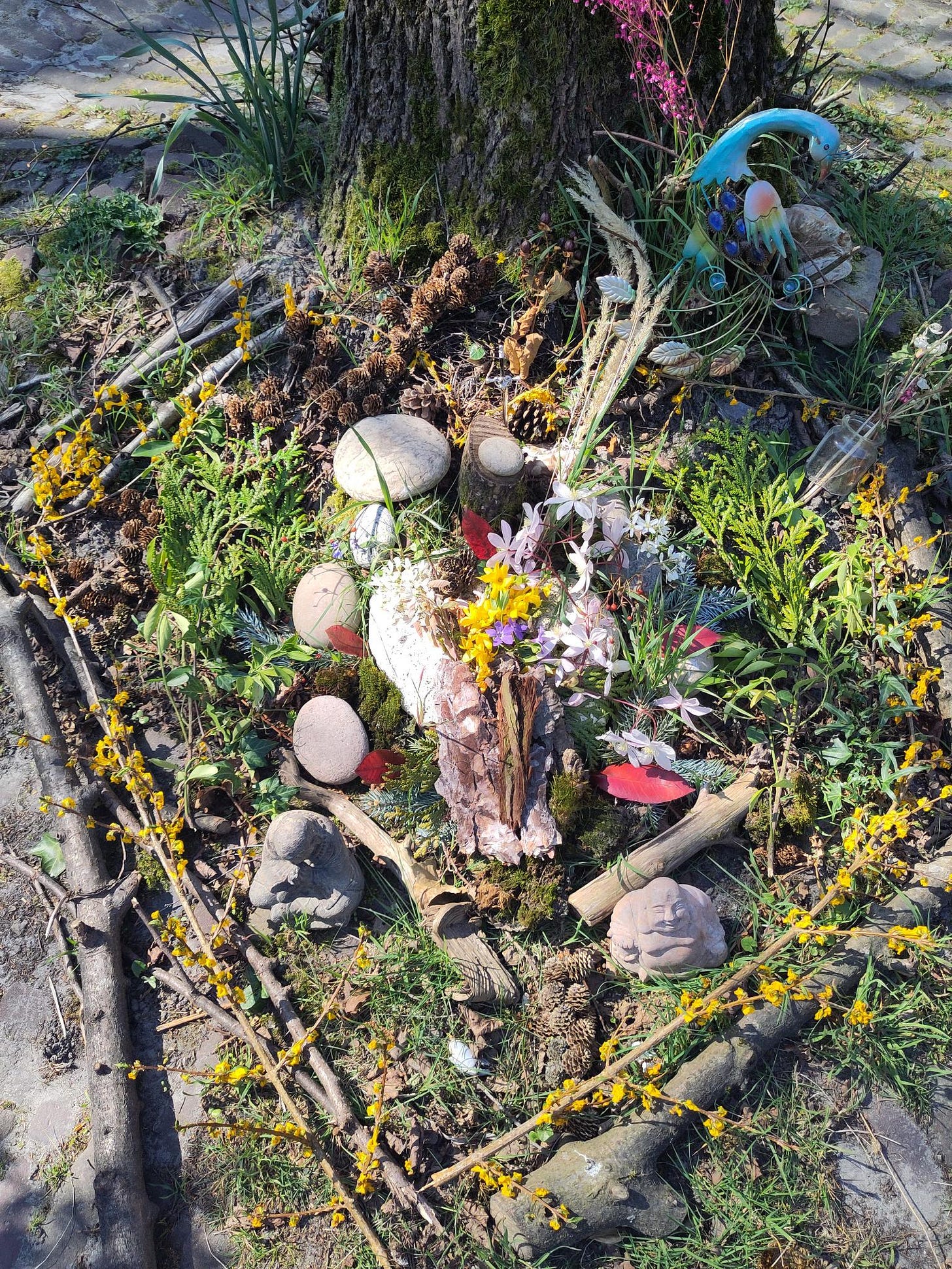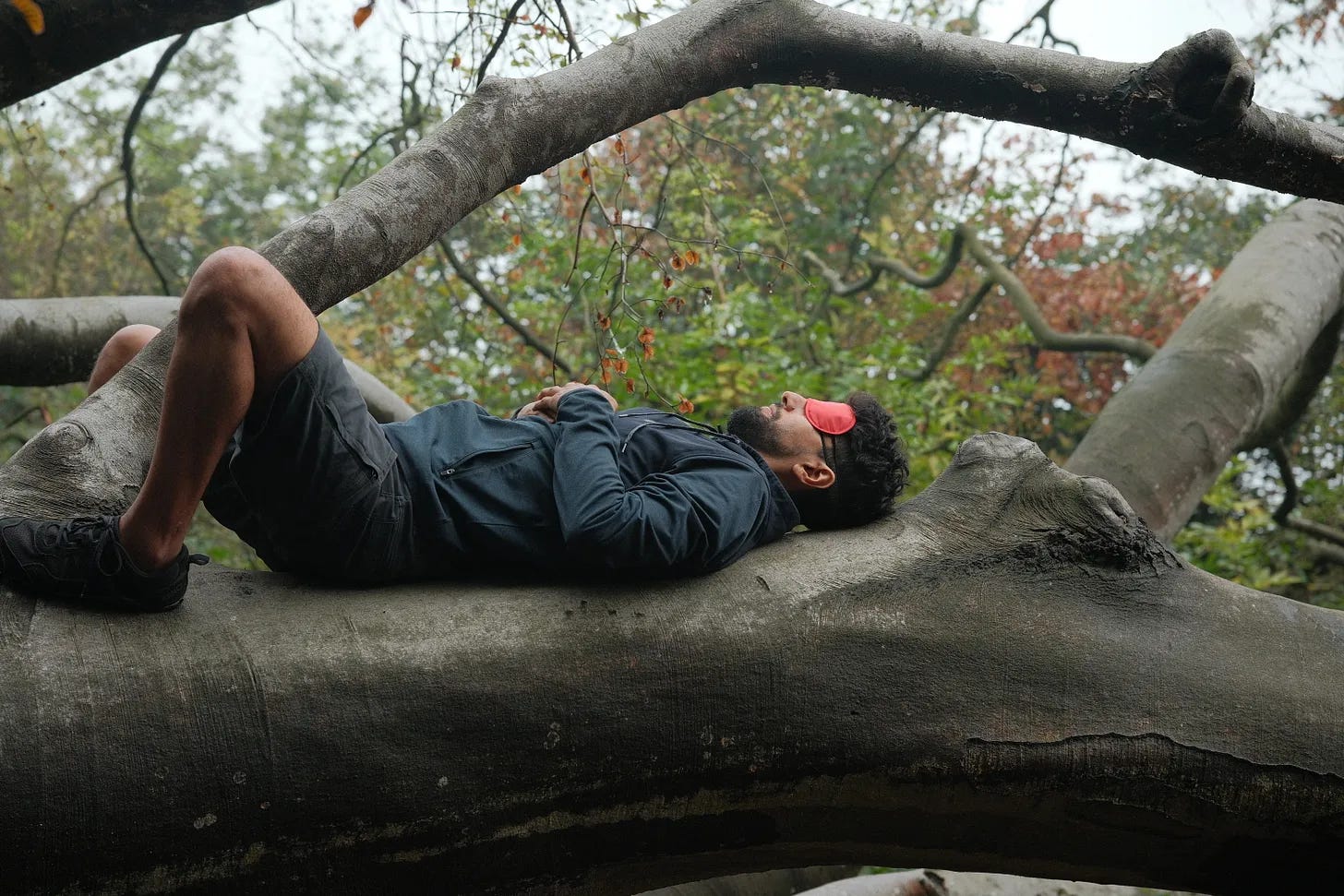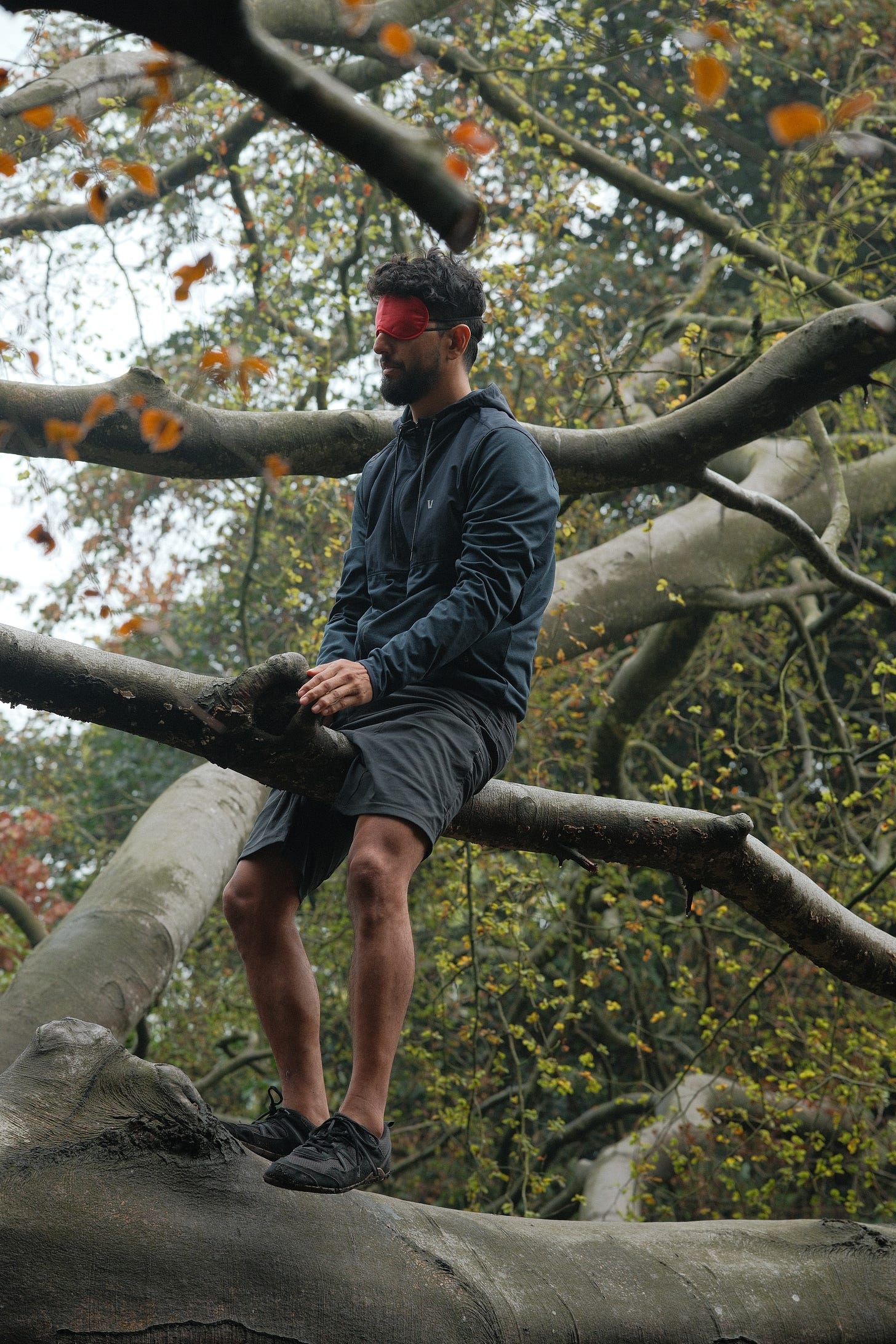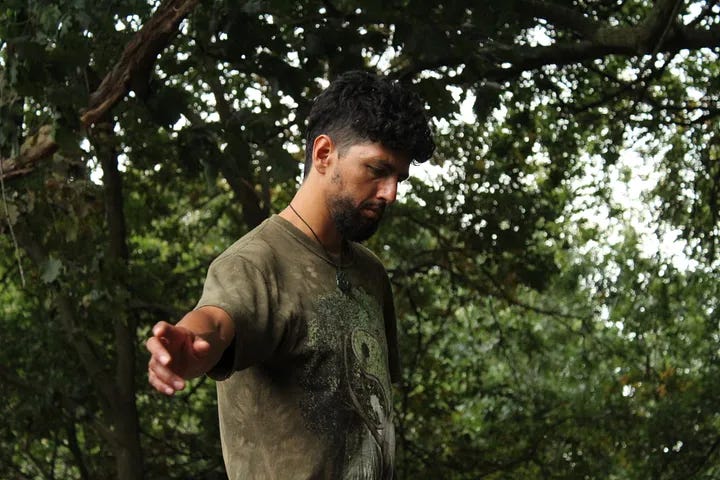Lost~ David Wagoner
The trees ahead and bushes beside you
Are not lost. Wherever you are is called Here,
And you must treat it as a powerful stranger,
Must ask permission to know it and be known.
The forest breathes. Listen. It answers,
I have made this place around you,
If you leave it, you may come back again, saying Here.
No two trees are the same to Raven.
No two branches are the same to Wren.
If what a tree or a bush does is lost on you,
You are surely lost. Stand still. The forest knows
Where you are. You must let it find you.1
Picture this: You are blindfolded, lying on a thick branch of a fallen two-hundred-plus-year-old beech tree. It's a lovely yet somehow chilly Sunday morning in September. You can hear wanderers with their dogs and runners passing by. You are in Hampstead Heath, a bubble of nature in the middle of London.
A gentle piano plays—a subtle atmospheric and poetic piece of music over a Bluetooth speaker nearby, setting the mood for a calming wandering of the mind with a melancholic twist. (This is so inspired by Satie's Gymnopédies!)
You sense other people scattered around the tree, each having their own inner journey and listening to the story being told without words. I have only a vague idea of where everyone is in relation to me, and I appreciate my little corner of humble tree-verse real estate. This is likely what birds and other tree dwellers must think: I feel safe here for now!
The prompt is simple: wander in respectful silence around the tree and feel whatever needs to happen. Feel. Just feel.
If this sounds somewhat like part of your friend's ayahuasca trip report, you're not too far off—except no medicine was used in this workshop. Nothing but oxygen from the air and oxytocin induced from being in your body with others who share the same reverence for movement and the wisdom of nature.
After being separated from my sense of sight, my mind slowly gives more space to my other senses. My hearing is sharp and good at discerning nuances, but I feel called to give more room to touch, smell, and even taste.
So I begin to gently come off the branch, still blindfolded, and venture about to heed a silent calling.
I had become somewhat familiar with the main sections of the tree the day before, when we explored fundamentals of movement through climbing, parkour, and dancing. But in darkness, the bittersweet music brings something haunting to this endeavor.
Thoughts emerge of potentially falling, breaking a branch, stumbling, hurting myself or someone else. I feel vulnerable but also trust myself, knowing this will end soon and that I'm in London, not the jungle.
I feel like a toddler scouting on all fours, exploring a new playground, aware that a figure of authority is nearby watching over me and trusting this will be good for me.
Earlier this year in my post about "Moderation as a Virtue," I mentioned a weekend workshop I joined in London on movement inspired by trees. The event occurred in September last year, and among many fun activities, one exercise left a profound impact: The Tree-Wandering-in-the-Dark moment!2
Something in the whole setup created a slow, increasingly deep presence leading to that moment.
The workshop had started with Ben Medder warming us to being in our bodies through simple movements initiated from our roots. For example, if you feel like doing a twist, sense how little would happen if your heel or big toe didn't prepare you for it and help shift your weight.
After rediscovering our own balance, the prompt asked us to focus on our trunk, more precisely our pelvis. In a world fixated on being smart or looking good and reading facial expressions, this felt oddly refreshing.
Zoom and Teams meetings are great, but they've reduced what we see of each other to heads, shoulders, and hands. They can distort what we need for a healthy communication. All the non-verbal communication from the rest of the body gets lost. (Is this person twitching their knee? Are they crossing their legs? Are they fidgeting? How are their hands positioned?)
As music helped ease us into movements without being too conscious of our newly discovered body mechanics, I had flashbacks to TikTok dancers and Bollywood inspired groups who dance primarily with their upper bodies and hands at shoulder level to enhance facial expressions.
They often seem in service of excitement, joy, and perhaps pretentiousness—think Madonna and her En Vogue video. (Nothing wrong with moving primarily with the upper body, by the way.) Contrasting this with the wisdom of moving from the roots of the body feels like a long-overdue homecoming.
Moving from the pelvis opens deeper energies. There's a serenity that emerges. Shoulders, neck and facial muscles seem to relax. For me, this translated into a certain sovereignty—I don't have to impress anyone. I'm a mediocre and sometimes insecure dancer, dreading partner dances where my lack of expertise shines through.
I start to experiment with slower time signatures riding above the melody. I sense that if I mess up a move, focusing back on the simplicity of movement from the hips will bring me home. And that's all that matters.
Ben's mantra for this is: Find your roots!
Back to the fallen beech tree—I'm now on the ground with my hands on the trunk, lowering my back to explore other branches from the other side. I recognize a section where I could crawl under and over repeatedly. After checking with my fears, I try a semi-controlled vault I had somewhat mastered earlier. Doing this in the dark now feels almost magical.
I hear others through the noises of their jackets sliding down branches and stepping on twigs. And always that bittersweet piano in the background. At some point, I slow down and hear someone finding a water puddle nearby. They seem to rediscover how this feels and sounds. Images of childlike innocence emerge. (Are they trying to communicate?)
The previous day, after Ben's slow awakening session, Opal—an accomplished, graceful, stoic, and rather introverted climber—took us to a magnificent oak tree to help us rediscover our ancestral relationship with trees. She asked us to hang, climb, and descend in different ways, feeling which positions felt better, more efficient, more dynamic, more intuitive. How to recognize a potentially breaking branch from a healthy one? How did this all feel?
The exercises weren't meant to help us climb fast, or high, or athletically, but to use movement in the tree to understand our bodies and ourselves better. Although I consider myself a proficient tree climber, I rediscovered how, relying more on touch to navigate multi-dimensional space, I wasn't just touching and feeling the tree. A plain and obvious fact emerged :
This tree is touching me!
How does it feel to be touched by this branch rather than another? What if the tree is simply luring us in to get us to know it better? What if the tree wants us to be in it?
This insight shifts my perception from seeing the tree as an inert object to conquer into viewing it as a partner.
As I learn to be careful around certain branches and feel cocky around others, a thought emerges that the tree is assessing me too. This occurs when a slippery branch humbles me as I don't land as expected, or when I get a scratch on my inner elbow. When I slow down and become gentle again, the flow feels like a partnership—more dance than fight or climb.
As we descend, we share our personal insights. The overall feeling is that we are more welcome to engage with trees than we thought. As adults, we typically see trees as sources of food, wood, or shade.
We often caution our children when they climb trees. We'd feel safer if everyone simply ignored them. Many adults walk past magnificent trees without acknowledging their presence, let alone climbing them. Apart from thorny trees, I feel many would like to be engaged with. Children seem sensitive to that call, and we should encourage them to engage respectfully.
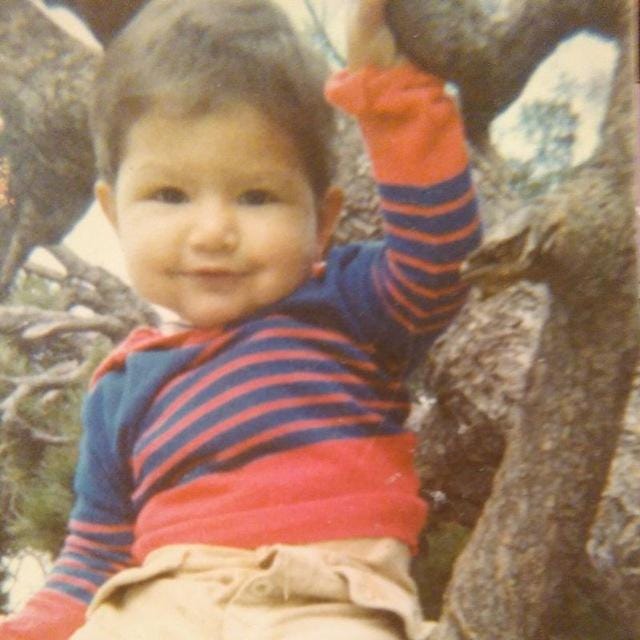
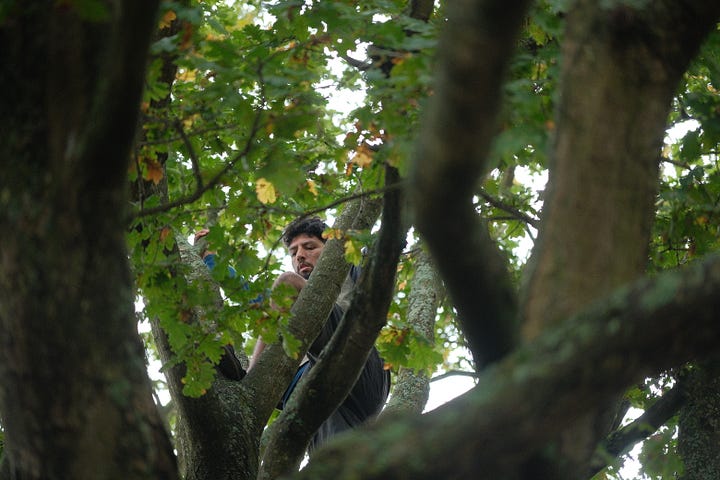
The subsequent group discussion triggered a memory of a podcast mentioning that monkeys often prune trees by breaking off dead branches. After being monkey-like that morning, I understood why. A dead branch endangers a heavy tree climber. I'm doing the tree a favor by removing branches that might carry disease, fungi, or parasites.
Back to the beech tree with the piano piece and my blindfold. I feel the urge to slow down again and lay my ear against what seems to be the main trunk. I hear others moving around, making the whole structure vibrate. The music has a haunting quality.
I stay there a while, as if decoding Morse code sent by an intelligent being from far away. In the darkness, after moving in all directions, my body somehow feels almost lost in space. Is that what astronomers do with the SETI program? Is this what being an astronaut feels like?
What if we were all lost and drifting in space? Longing to connect deeply with another soul? It's so lonely here in this body, in this realm. Is there anyone out there who can acknowledge me? I want to be seen. I want to feel seen. I feel there are other beings out there, but do they want to engage with me? Is that our fate? To be lonely and crave infinite connection?
As if no one approaches, I continue my journey and sense someone sitting nearby. After being with this small group, I have some idea who this might be, but I'm not certain.
I am sure, however, that we're not perfect strangers and that we share common values, brought together by this workshop. They seem still and peaceful. I feel their back and the fabric of their jersey. They feel masculine and calm. And giving them the hug that I was craving for feels right.
I'm happy to reach out and hold them the same way I've been holding tree branches—as a way to feel anchored in an unstable environment and provide a solid haven to "the Other."
I am touching the tree, and the tree is touching me. If the tree is an avatar for Supreme Intelligence, then we both need each other to help It understand Itself. More pragmatically, even if you don't believe in Spinoza's panpsychism, we can agree that touch is essential to healing and growing more efficiently than through words alone.
Words are important. But without movement and touch, they can become a hall of mirrors—ideas pointing to ideas, endless and pointless ruminations. The right words will propel us toward deepened experience, encouraging us to feel and explore more.
When the music ends, there's a common sense of grief among the group. Everyone seems to have taken a step toward a painful yet beautiful insight for their journey. Some rush to notepads to jot down urgent thoughts. Others continue holding each other. Shortly after, we share impressions, and some remain overwhelmed.
The most powerful insight for me came from Alisson, a forest bath facilitator and healer from the west coast of France—a thought that delivers a powerful blow to Descartes' "Cogito ergo sum":
The only thing I can be sure of...
are my sensations.
I nod in agreement and feels like another confirmation of an intuition that was made its way through my time contemplating my relationship with words and the nature of reality. What are thoughts without the sensory mechanism that triggers them? Ideas can trigger ideas in a chain reaction manner. But ultimately the spark comes from a sensation, a feeling, or a stimuli.
What if God was this tree-like entity wanting to understand itself through feeling.
Breath, connect and transcend…
Breath, connect and transcend…
Breath, connect and transcend…
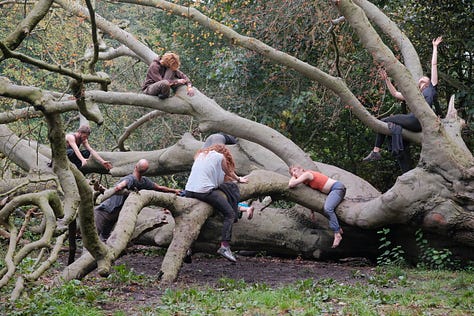
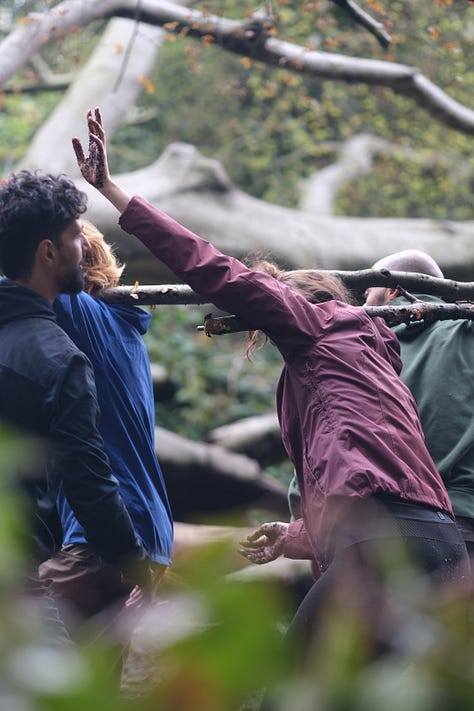
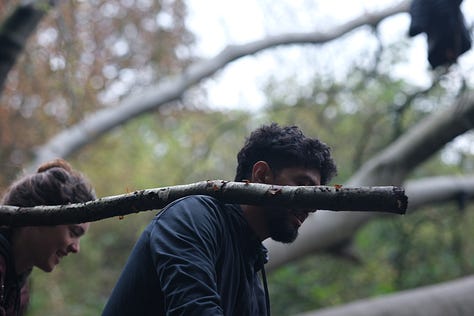
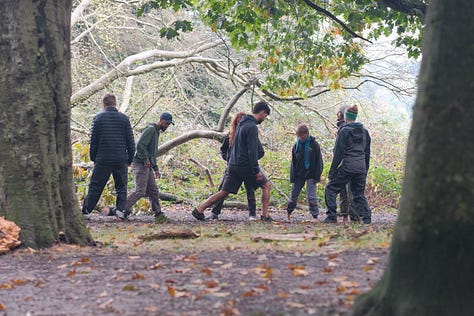
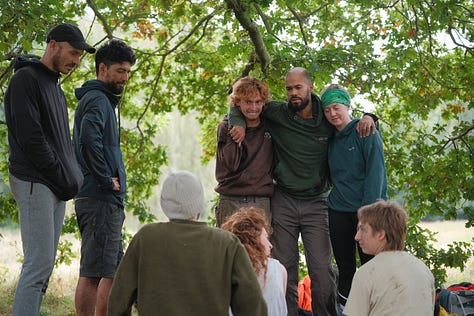

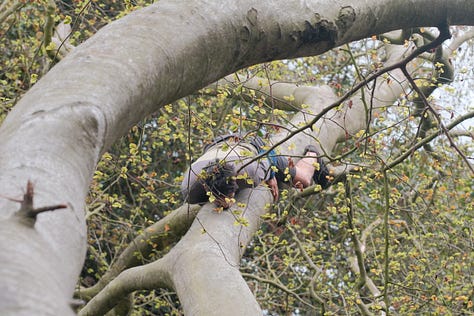

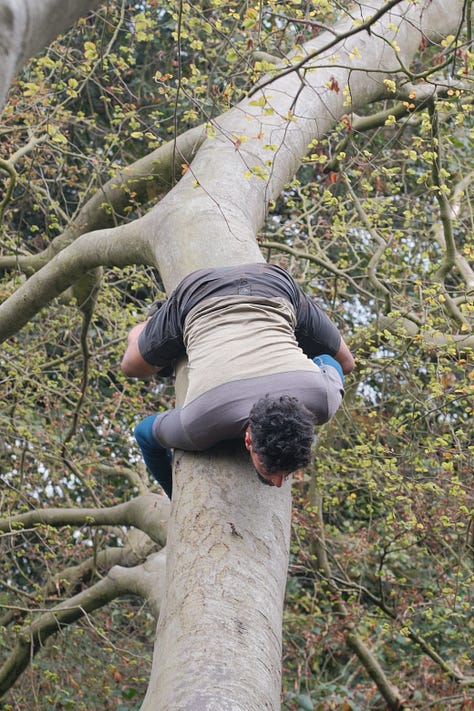
If you are lucky enough to be able to go be in the UK in June 2025, make sure you check out Ben’s, Chaz and Opal’s offerings here and here.
Thank you Tamara for sharing that lovely poem
Thank you Chaz for that powerful and simple exercise. I think we all got so much out of it.
Music credit from Niels Frahm.
A place
Lighter
My friend the Forest


